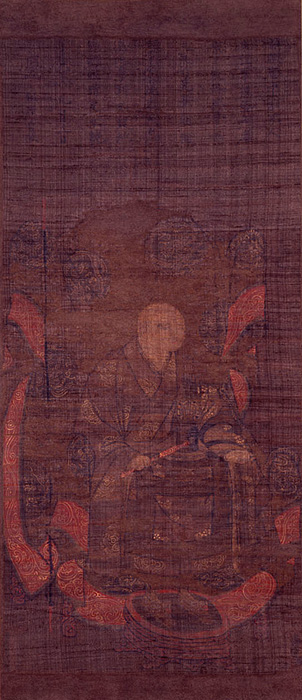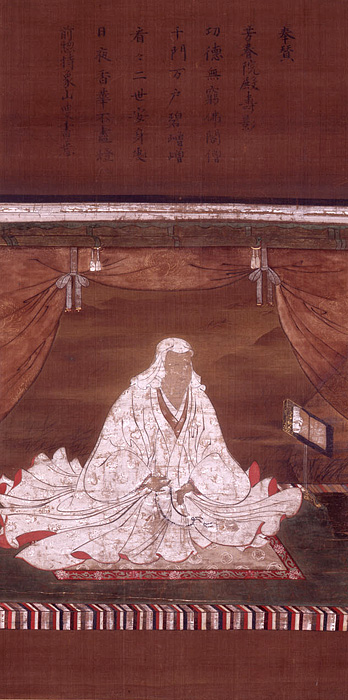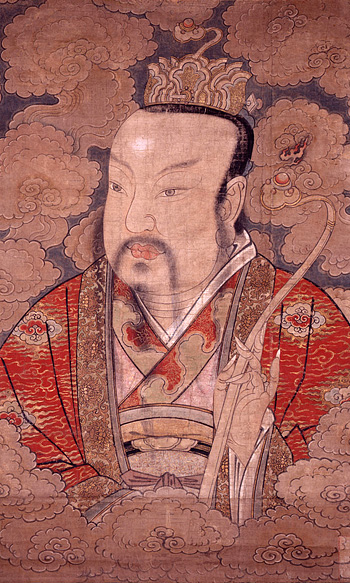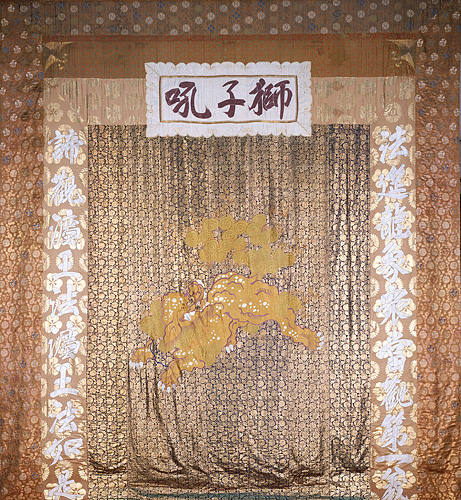Important cultural property
Statue of Keizan Jyokin, One original

Colored silk artwork
H: 89.2 x W: 38.6cm
Kamakura era, year Genō 1 (1319) With original sign.
Artwork of Sojiji founder, Keizan Jokin.
Usually, the portraits of Zen Masters are called “Chinzo”, sitting on a chair, wearing a Buddhist robe painted in an orthodox technique. There is an original sign on the top, September 8th, year Genō 1 (1319) on the age of 52.
Historically speaking, if the date is correct, the portrait was painted when he was the abbot of Yokoji before he entered Sojiji. There is no flaw on the drawing and it is a well- balanced artwork. The painting shows his flat forehead which is similar to the wooden statue of Yokoji and presents the features of Master Keizan.
Portrait of Wife of Toshiie Maeda, One original

Colored silk artwork
H: 101.0 x W: 50.3cm
Edo era
This portrait shows Matsu, the wife of Toshiie Maeda. When Toshiie passed away in the year Keicho 4 (1599), she cut her hair to become a priest with the Buddhist name “Hoshunin” and was painted as a nun wearing a Buddhist robe and with a Buddhist rosary in her arm, sitting on an elevated tatami mat and with kinds of curtains. Chinese black and white mountains are drawn in the background which is of the same pattern as the portrait of Toshiie Maeda.
There are words of Zozan Joun that Toshiie and Matsu had deeply embraced in Buddhism. Zozan was the 1881st abbot of Sojiji, and also the founder of the temple Hoshunin which is known as one of the main sub temples of Sojiji. The words “Hoshun-in-den Juei” are written, meaning that it is a statue her living life.
Portrait of Devadatta, one original

Colored paper artwork
H: 150.2 x W: 91.6cm
Kōrai Dynasty period.
A portrait of Devadatta known as a cousin of Buddha.
The skin of his face is painted in yellow-white color and his eye and nose are drawn in dark grey lines, the lips are drawn in red. Hair and beard are drawn carefully with dark grey lines, the Buddhist robe is painted in gold, entirely bright and warm colors are used. The eyes are gazing forward, the tightly closed mouth shows his intelligence.
He became an apprentice of Buddha, but then opposed him and did evil things afterwards. Finally he went to hell alive. Chapter 12 of Lotus Sutra says that Devadatta rests in peace by the blessing of Lotus Sutra.
Large embroidered Buddhist robe “Shishiku” (lion’s roaring)

H: 715.0 x W: 665.0cm
Edo era
The robe is usually used for decoration of Buddha Statues inside and outside the temple. It is usually called “Happi” and especially used to decorate the stage for a Buddha image.
At Sojiji every year on October 15th (the last day of Goshōki ceremony for the two founders), it is hung on a specially installed stage in the main hall, and the chief abbot stands in front for Zen debate. Not only a supreme artwork of dying and weaving of early Edo era, it is also a very precious Buddhist item.
The history of Kannon-dō hall, Written by Master Keizan Jyokin

Kamakura era year Genryō 1 (1321)
It describes that according to the dream of Keizan Jokin, he received the Shogaku Kannon-dō and the real estate area from Jōken risshi.
He re-established the Buddhist Monastery to a Zen Buddhist Monastery and renamed Shogakusan to Sojiji. It is said to be one of the few papers written by Master Keizan himself and states the core basic history of Sojiji.
